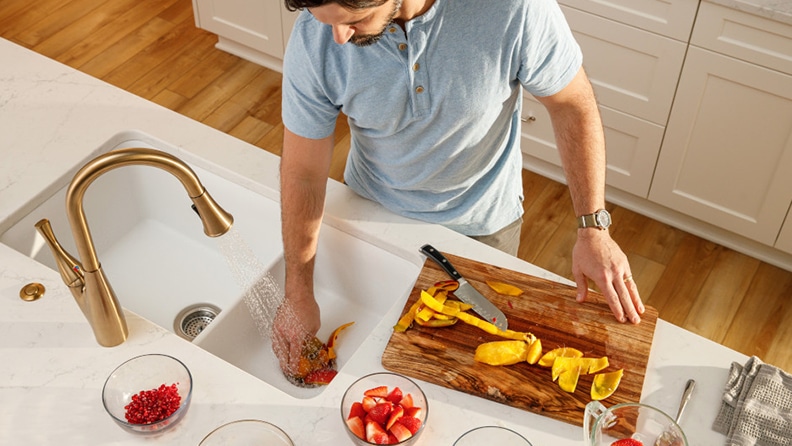Recommended Methods for Resolving a Leak in Your Garbage Disposal
Recommended Methods for Resolving a Leak in Your Garbage Disposal
Blog Article
This great article listed below relating to Why Is is indeed stimulating. You should take a look.

Waste disposal unit are necessary cooking area devices that aid in disposing of food waste successfully. Nevertheless, a leaking garbage disposal can be an irritating and untidy trouble to manage. Fortunately, numerous leakages can be dealt with conveniently with a couple of straightforward actions. In this article, we will discuss how to fix a leaking waste disposal unit properly.
Intro
Waste disposal unit are set up under kitchen area sinks and are developed to shred food waste into smaller sized items, enabling it to pass through the pipes system quickly. While these devices are usually trusted, leaks can occur with time because of wear and tear, loose connections, or damages to the device.
Typical Reasons For Leaks in Waste Disposals
Worn Seals and Gaskets
Seals and gaskets play a critical duty in avoiding water from leaking out of the waste disposal unit. In time, these components can weaken, resulting in leakages around the disposal device.
Loose Connections
The links between the waste disposal unit and the pipes system can end up being loosened gradually, triggering water to leak out during procedure.
Splits or Holes in the Disposal System
Physical damages to the garbage disposal, such as splits or holes in the real estate, can likewise result in leakages.
Recognizing the Source of the Leakage
Before trying to fix a leaking waste disposal unit, it is necessary to determine the resource of the leakage. This can normally be done via visual evaluation or by performing simple tests.
Visual Evaluation
Inspect the garbage disposal device very carefully for any type of signs of water leak. Pay very close attention to areas around seals, gaskets, and connection points.
Testing for Leakages
One means to check for leaks is by running water through the disposal unit and checking for any type of visible signs of leakage.
Devices and Materials Needed for Repairing a Dripping Waste Disposal Unit
Prior to starting the repair process, gather the needed tools and products, including a screwdriver, adjustable wrench, plumbing technician's putty, substitute seals or gaskets, and epoxy or patching product for repairing cracks or holes.
Step-by-Step Guide to Repairing a Dripping Waste Disposal Unit
Shut off the Power
Before trying any kind of fixings, make sure that the power to the waste disposal unit system is turned off to prevent the threat of electrical shock.
Situate the Leakage
Recognize the precise area of the leak and figure out the cause.
Tighten Connections
Use a wrench to tighten up any type of loose connections in between the disposal device and the pipes system.
Replace Seals or Gaskets
If the leak is because of used seals or gaskets, get rid of the old parts and change them with brand-new ones.
Patching Fractures or Openings
For splits or openings in the disposal device, usage epoxy or a suitable patching material to seal the broken location.
Examining the Waste Disposal Unit After Repair Work
As soon as the repair service is full, test the garbage disposal by running water via it to ensure that the leak has actually been solved.
Preventive Upkeep Tips to Prevent Future Leakages
To prevent future leakages, it is essential to carry out normal maintenance on your waste disposal unit. This includes keeping it tidy, staying clear of placing non-food items or difficult items down the disposal, and periodically looking for leaks or various other concerns.
Final thought
Finally, taking care of a leaking garbage disposal is a relatively simple process that can be finished with fundamental devices and products. By adhering to the actions laid out in this short article and practicing precautionary upkeep, you can keep your waste disposal unit in good working condition and prevent expensive fixings in the future.
What to Do About a Leaking Garbage Disposal
A leaking garbage disposal often goes unnoticed until you confront a sopping cabinet, a foul-smelling puddle, or an audible drip-drip-drip from the unit. The fix can be frustrating, too, because the leak can stem from a number of components in the system. Fortunately, with a little sleuthing, you can zero in on the leak and—depending on the exact location—stop the icky oozing and repair the component that caused it. Worst case scenario, if it turns out that the garbage disposal must be replaced, installing a new one is a reasonable do-it-yourself task for those with basic plumbing skills. Read on to keep the cash you’d otherwise hand over to a pro.
Prepare to find the leak
Prior to testing the garbage disposal for leaks, unplug it at the wall outlet and turn off the power from the breaker box to prevent electrical shock. Then insert a watertight sink stopper into your sink drain and wipe the unit dry with a clean cloth. In any handy container, mix a few drops of food coloring into a few cups of water, and pour the dyed water onto the sink stopper to help you locate the leak.
Investigate the source
the top, where the disposal meets the sink drain the side, where the dishwasher hose or main drain pipe connects to the disposal or the bottom of the unit Inspect each of these locations while gliding a light-colored rag over the unit; the dyed water will readily show on the rag and reveal the location of the leak. If a leak isn’t immediately apparent, remove the sink stopper and pour a few more cups of dyed water down the sink drain, then check for leaks again. Leaks near the top of the unit are more likely to show themselves while the sink is plugged, while side and bottom leaks are more noticeable while the sink is unplugged.
The metal sink flange that sits directly inside the sink drain is typically sealed around the top with plumber’s putty (a clay-like sealant) and then secured from under the sink with bolts. If the plumber’s putty deteriorates, or the bolts loosen, the flange can no longer form a watertight seal between the sink drain and the disposal—which could cause a leak at the top of the unit.
To reseal the leaky flange, you must first detach the garbage disposal. Start by loosening the screws securing the main drain pipe to the disposal, then loosen the screws in the metal clamp securing the dishwasher hose to the disposal and detach the drain pipe and dishwasher hose from the disposal. Loosen the screws in the mounting ring that connects the disposal to the metal mounting assembly beneath the sink, then pull down the disposal and carefully set it on a clean, dry surface. Loosen the bolts in the mounting assembly with a wrench, then pull down the mounting assembly and set it near the disposal.

I was made aware of that write-up on Tips on Fixing a Leaking Garbage Disposal from an acquaintance on another domain. Kindly take a moment to distribute this blog if you enjoyed it. Thanks a bunch for your time. Please pay a visit to our blog back soon.
Visit Url Report this page